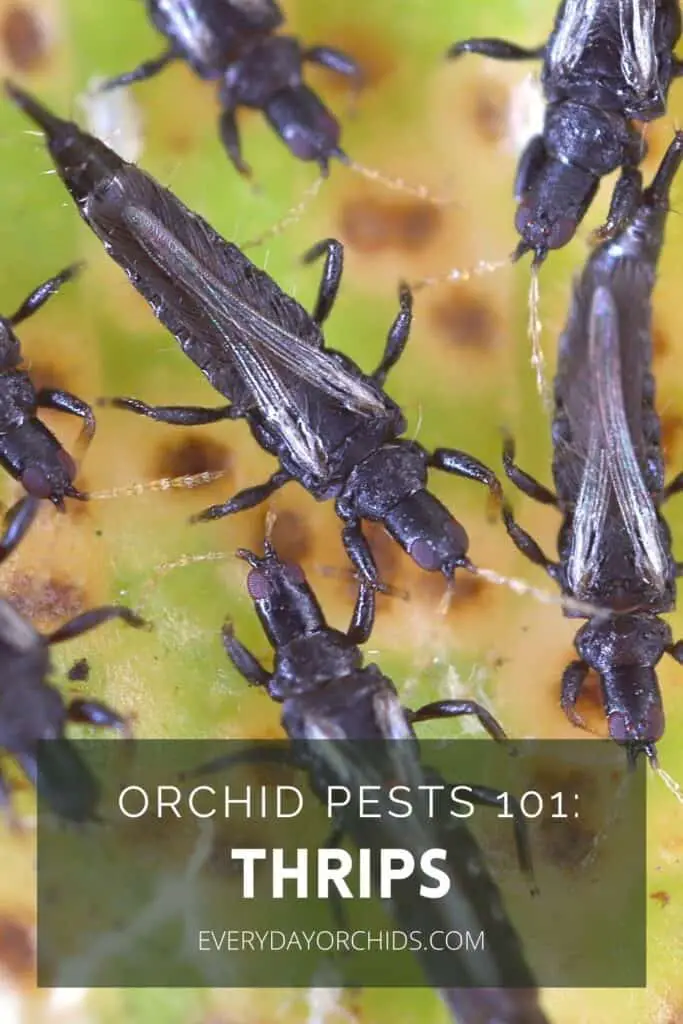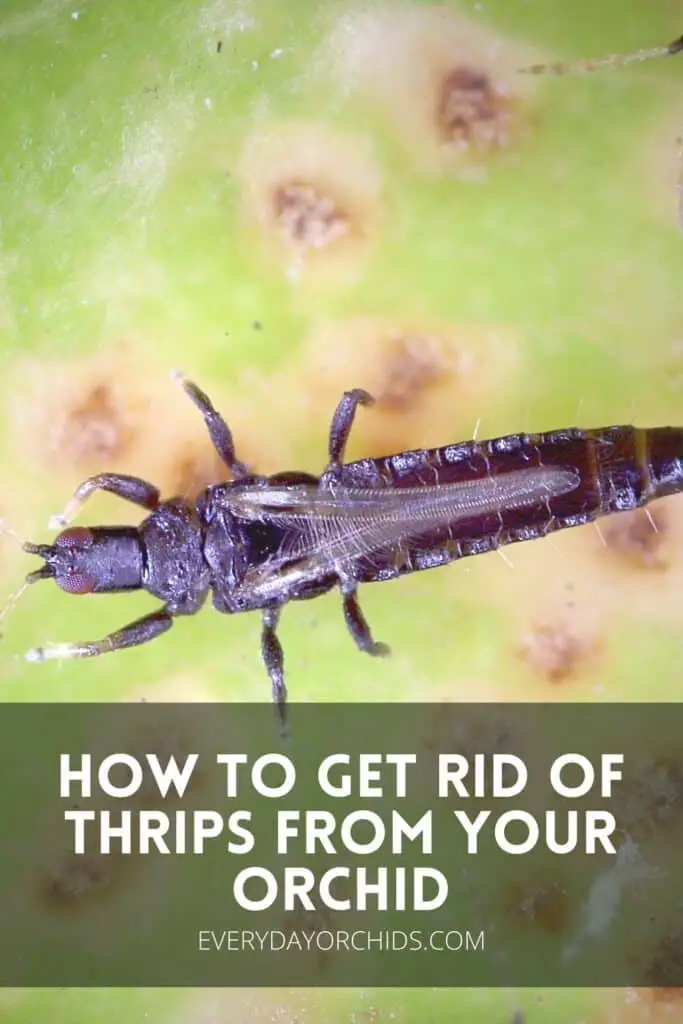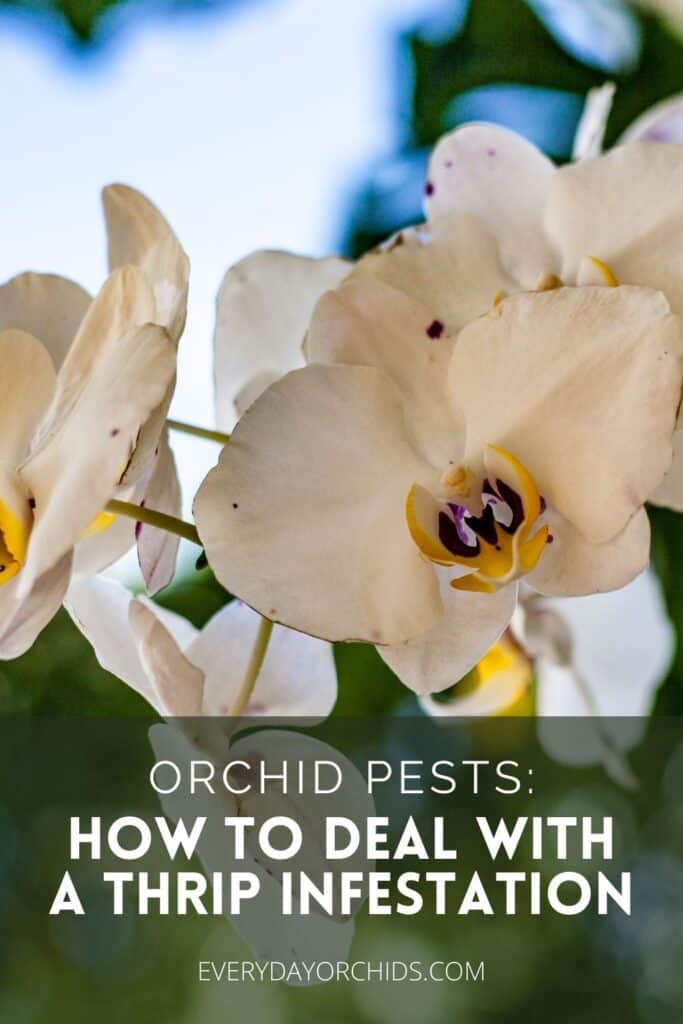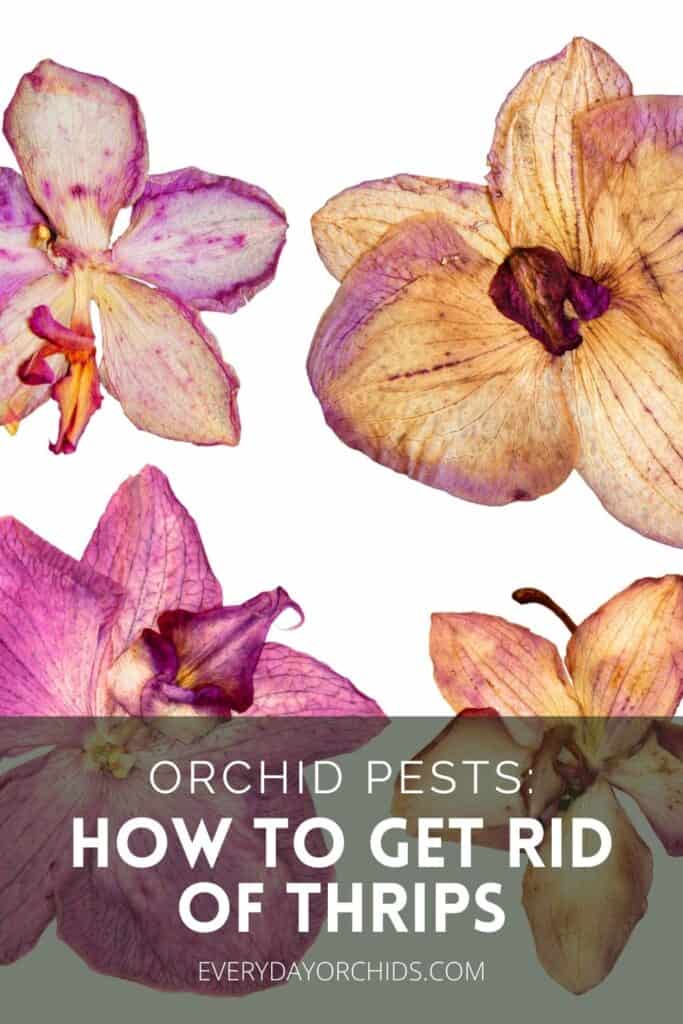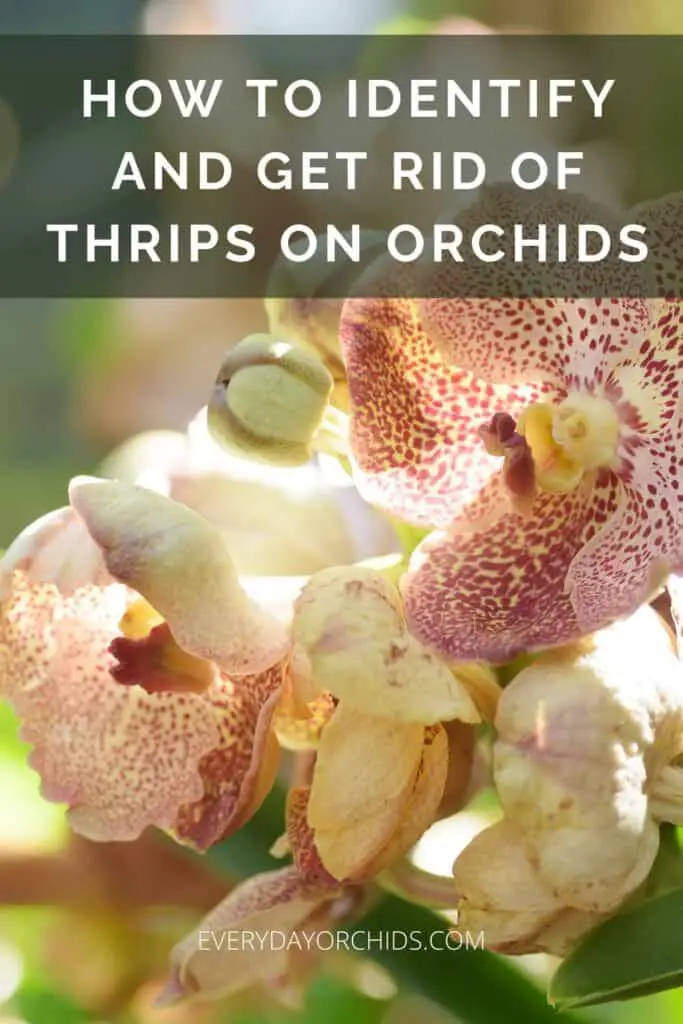Your orchid’s leaves are pitted and the flowers are falling off the spike unopened…could you possibly have thrips infesting your orchid? Thrips are notorious pests. They don’t just attack orchids, but can infest many types of plants found in the home and garden.
Thrips can do a lot of harm and spread FAST. Early intervention and treatment is key in getting a thrip infestation under control before serious damage is done to your orchid collection.
To get rid of thrips on your orchid, you can opt for natural interventions, such as spraying down the orchid with water, using neem oil, or natural predators. For serious thrip infestations on your orchid, you may need to reach for pesticides or insecticides that include malathion and acephate.
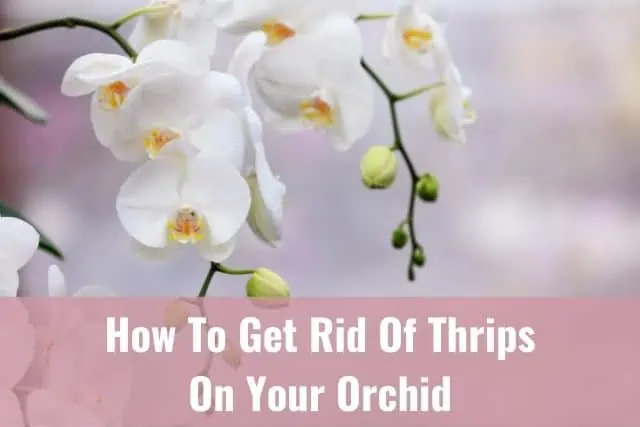
Dealing with a pest infestation is a headache for any orchid grower, but there are some easy ways you can deal with the pests and get rid of them with as little stress as possible.
In this article, I’ll go over the dreaded orchid pest: thrips. I’ll talk about what they look like so you can identify them. You’ll also learn what to expect with a thrip infestation.
In addition, I’ll give you some ideas of how you can get rid of them and treat the infestation with natural or commercial pesticides. Last, you’ll get some tips on how to prevent future thrip infestations on your orchids. Keep reading to learn more.
Please note that these links are affiliate links and as an Amazon Associate, I earn from qualifying purchases. Purchases made through affiliate links in this post may generate commissions at no additional cost to you. Use this link for a discounted Amazon Prime trial. Thank you for your support!
Table of Contents
All About Thrips And Orchids
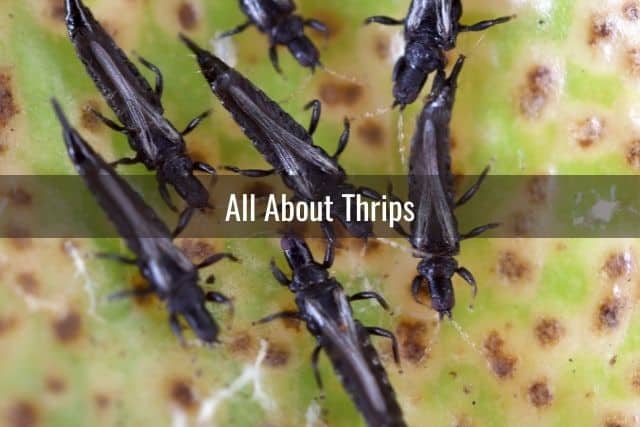
I talked about thrips briefly in my overview about orchid pests, but I wanted to go into more detail about how to identify and deal with these pests. Thrips most commonly infest Vanda, Dendrobium, Cattleya, Phalaenopsis, and Epidendrum orchids.
These pests are similar to aphids in that they use their mouthpieces to suck nutrients and sap from the orchid. They are also winged, much like fungus gnats. This allows them to move easily from plant to plant and spread quickly.
There are many different species of thrips, just as there are many different species of orchids. In this article, I’ll be talking about thrips in generalities, rather in relation to specific species. Don’t worry though, these treatment and prevention methods for a thrip infestation will still work across different species.
Besides, thrips are so small that it is difficult for the lay-person to identify them by species. You just need to know what a thrip looks like in the most general terms. This way, you can recognize a thrip infestation and start dealing with it as soon as possible.
What Do Thrips Look Like On Your Orchid?
If you aren’t sure if you have thrips on your orchid, here is a brief description of what they look like. Thrips are slender, winged insects, usually dark brown in color. Some thrips may be black or yellow-white, depending on the species or stage of growth.
These pests are tiny, ranging from 1/16 to 3/8 of an inch in length. They can be mistaken for specks of dust and are easy to miss with the naked eye. They are so small that they often escape notice and can do a significant amount of damage by the time you realize your plant is infested.
Thrips often hide out in orchid flowers or along the undersides of orchid leaves. To check if your orchid has thrips, wipe the underside of an orchid leaf with a white paper towel to dislodge the pests. Alternatively, shake the orchid flower in question over a piece of white paper.
Carefully examine any tiny bugs that fall onto the paper or are captured by the paper towel. If you see tiny, slender brown or black pests crawling along on the paper towel, these are likely thrips. To see the wings on the thrips, you may need a magnifying glass.
However, be aware that definitive identification of the pest isn’t always necessary. Thrips are hard to spot. They can hide in the potting media, in the crevices of leaves and flowers, and even in the flower buds.
Instead, you can often identify a thrip infestation just by looking at the type of damage found on your orchid. In fact, this is how most people first recognize that a thrip infestation is underway. If you are curious about what I’m talking about, read about how thrips damage orchids to learn more.
Life Cycle Of Thrips
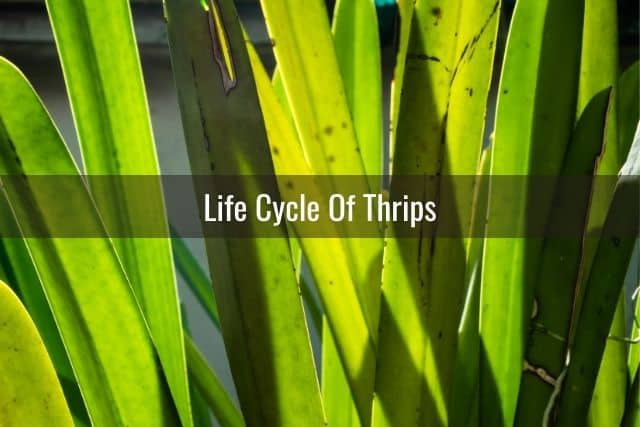
Many orchid pests I’ve talked about here on Everyday Orchids have a short life cycle. This means, within as little as one month’s time, the pest population can exponentially increase. Left unchecked, the population can explode from a small, manageable infestation into a large-scale infestation. Unfortunately, thrips are no exception.
Thrips can grow exceptionally fast. In warmer weather, with the right temperature and humidity conditions, a thrip can develop from an egg into a fully grown adult within just 3 or 4 days. In the winter, when the weather is cooler, it may take a thrip up to 2 weeks to grow from an egg to an adult.
An adult female thrip can lay up to 50 eggs at a time. Generally these eggs are laid just beneath the surface of the orchid’s plant tissue, usually in the leaves or stems.
A callous forms over the eggs, further damaging the plant. The callous also protects the eggs from insecticides and other treatment options, making it necessary that you do repeated pest control treatments, spaced several days apart. This will allow you to target any newly hatched thrips.
Within a few days, the eggs hatch and yellow-white nymphs emerge. These nymphs will immediately start eating the orchid tissue and sucking out the sap where they can.
As they grow older, the nymphs go hide in the potting media and continue to develop into adults. The next time you see them, it will be in their winged adult stage. As adults, they will continue to feed on the plant, lay eggs and begin the next generation’s life cycle.
Depending on the weather and season, this can all happen in a matter of a few days. It takes almost no time at all for a thrip population to double or quadruple in the summers.
What’s worse, because these are winged pests, thrips can quickly spread and infest your entire orchid collection and other neighboring plants in just a short time.
How To Deal With Thrips On Your Orchid
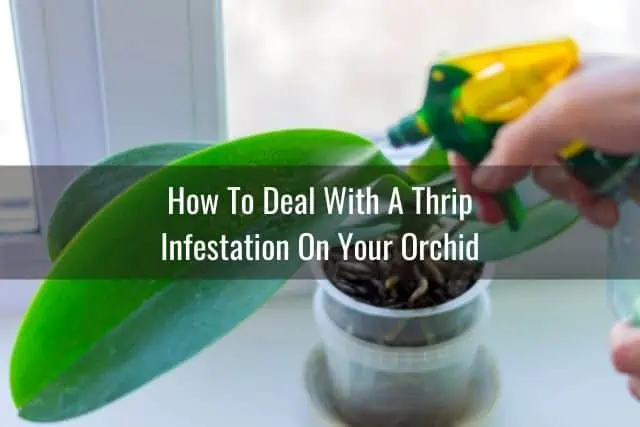
Thrips are unfortunately resistant to a lot of the traditional pesticides out there. There are a few options for dealing with a thrip infestation and I’ll go over them below.
If you have a very small infestation, restricted to just one or two plants, the first thing you’ll want to do is isolate all the affected plants. Put them in an area away from all your other houseplants. This will minimize the risk that the thrips will continue to spread to other plants.
Meanwhile, continue to monitor all the other plants over the next few weeks. Look for signs of a thrip infestation in those plants each week. If you see anything suspicious, isolate those plants as well.
Before you apply any products, do what you can to reduce the numbers of thrips present on your plants.
You can do this by using a damp paper towel to wipe down the undersides of your orchid leaves. Be sure to fold over the paper towel and use a clean side for subsequent wipes. While this won’t get all of the thrips, it will help remove some of the adult thrips manually.
Water Spray
One simple and low-cost method to get thrips off your orchid is to spray your orchid down with water. You can rinse your orchids off outdoors or in your kitchen sink. Focus on areas where thrips might hide, such as leaf joints or the underside of leaves.
I would recommend doing this early in the morning to allow excess water to dry off before nightfall. After spraying down your orchids, get a paper towel to remove excess water from the leaves and leaf joints. Try to soak up water in the crevices between the leaves and stem.
If you are dealing with a Phalaenopsis or Vanda orchid, remove any standing water from the orchid’s crown and leaf joints as well. This will help prevent problems such as stem rot or crown rot down the line.
Insecticidal Soap
Insecticidal soaps, such as Bonide Insecticidal Soap and Safer Houseplant Insecticidal Soap, can be used to address a thrip infestation. The majority of these soaps are non-toxic and can be used safely inside the home.
Insecticidal soaps work by breaking down the insect’s protective outer covering and damaging the insect’s cell membranes. This leads to the insect’s eventual death.
Most of these products come in ready-to-use spray bottles. To apply, spray the orchid liberally in the morning, focusing on areas where thrips tend to hide: flower buds, along the flower spike, between the leaves and stem, on the underside of leaves, and at the root tips.
You can also spray the insecticidal soap over the surface of the potting media to target any nymphs hiding there. Once you spray, allow the treatment to sit and work. Avoid watering your orchid soon after applying the treatment.
You will likely need to do repeated sprays or applications, spaced several days apart. Do this until the thrip population is reduced to manageable levels or is gone.
Sticky Insect Traps
You can opt to use sticky insect traps to capture some of the winged adult thrips. Yellow or blue sticky traps will work to trap any adult thrips flying near the orchid. Position these traps around your orchid plant. I talk about these traps extensively in my fungus gnat article, so check that out.
Thrips will appear on the sticky traps as tiny dark dots or specks. If you see dark specks start to collect on the sticky traps around your orchids, pay attention. There may be a thrip infestation brewing.
Note: These traps can help you identify a problem, but not solve it. In other words, sticky traps are spotting methods. Some of the winged adults will get caught in the trap, but not all. You will still need to get to the root of the problem and kill the thrips themselves.
Neem Oil
To actually kill the thrips, you can use a horticultural oil such as neem oil. Neem oil is a very popular, natural method for dealing with orchid pests. It works by smothering adult pests, preventing them from moving between plants. It also disrupts the egg and larvae stages of development of various pests, breaking the cycle of growth and reproduction.
Neem oil works great against thrips and other orchid pests, such as spider mites, aphids, mealybugs, and scale. The other great thing about neem oil is that it is safe to apply around pets and young children. You can use this indoors without worry.
Preparing The Neem Oil
To use neem oil, you’ll need to first dilute it, unless it comes in a ready-made solution. Most cold-pressed neem oils will need to be diluted.
To prepare the neem oil solution, mix 5ml of neem oil with a squirt of gentle dish soap or Castile soap in 1 quart of water. Shake the solution if needed to help the oil disperse evenly into the water. Pour the mixture into a spray bottle with a fine mist spray. Spray generously on all affected areas on your orchid.
Apply the neem oil solution onto your orchids early in the morning. Also, keep the orchids out of direct sunlight to prevent the leaves from burning. You will likely need to do repeated applications spaced several days apart until all the pests are gone.
Where To Buy Neem Oil
If you aren’t sure where to buy neem oil, you can easily find it online. Here are some suggestions:
- Cold-pressed neem oil for plants: cold-pressed neem oil will need to be diluted before use, so a large bottle like this will go a long way. Store the opened bottle in the refrigerator to help it last longer.
- Bonide ready-for-use neem oil solution: This comes in a 2-pack and is, as it says, ready-made, which means no diluting or mixing required. It is ready-to-use out of the packaging. It kills eggs, larvae and adult pests. As soon as you get this Bonide neem oil spray, you can start treating your affected orchids. I’ve used this product with good results.
- Organic neem oil with high azadirachtin content: This neem oil is also cold-pressed, which means you will need to dilute and prepare it before use. The high azadirachtin content means that it is particularly effective at killing orchid pests.
I go into more detail about how to buy and use neem oil on your orchids in a separate article on Everyday Orchids. If you are considering using neem oil to deal with the thrip infestation on your orchids, I strongly suggest you read the other neem oil article for more detailed information before you start.
Natural Predators
Depending on where you keep your orchids, this may or may not be a viable option. Natural treatment options include introducing natural predators, such as predatory mites, to help bring down the thrip population.
Obviously, if you keep your orchids inside your home, you may prefer not to use this option. However, if you keep your orchids outdoors or in a greenhouse, you may want to look into purchasing some natural predators and introducing them to your orchid collection.
Natural predators such as predatory mites can be a very effective way to deal with a widespread thrip infestation. Think of it as outsourcing the job or hiring hit men to take out the thrips for you.
You can buy predatory mites online. Here are a couple of suggestions:
- Live Predatory Mites (2,000 count).
- Nature’s Good Guys Live Mites (12,500 count).
Simply shake the container of mites out over your orchid and the surrounding potting media. The mites will quickly disperse and go into hiding. You won’t be able to see them, but you’ll need to trust that they are doing their job.
If you do use natural predators, don’t use an insecticide or pesticide on your orchids at the same time. Doing so will, of course, kill the natural predators that you just bought. Insecticides and pesticides will kill all pests indiscriminately.
Insecticidal Treatments
Sometimes, for severe or widespread thrip infestations, you just have to reach for the big guns to deal with the problem. I’m not a fan of using insecticides, especially inside the house, but sometimes this is the best treatment option for a severe infestation.
If you do need to spray your orchids down with an insecticide, do it in a well-ventilated area. Wear gloves to protect your skin. If any insecticide gets on you, immediately wash it off. Keep pets and young children away while you are applying the insecticide.
Insecticides containing malathion and acephate, such as Orthene, will be most effective for dealing with thrips. Garden Safe Insect Killer and Botanigard are two other insecticides used for treating thrip infestations on orchids.
As always, follow the product directions when using and dilute if necessary. Spray the orchid down thoroughly and repeat treatment every 5 days until you no longer can spot any thrips.
It is always best to rotate between products and different treatment methods. This helps prevent the pests from building resistance to any one product.
Preventing Thrips From Infesting Your Orchid
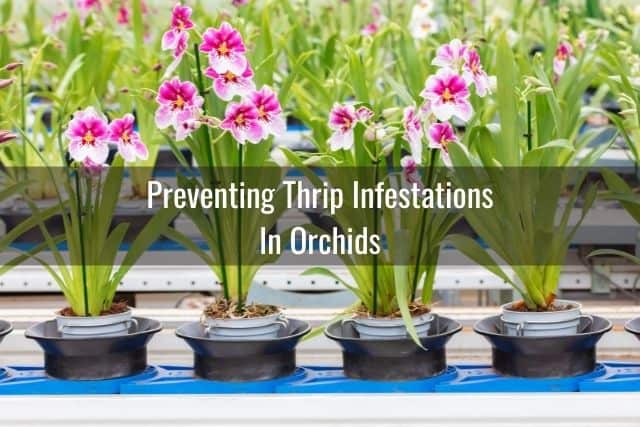
Obviously, it is better not to have to deal with a thrip infestation in the first place. There are several easy actions you can take to prevent thrips from attacking your orchids to begin with. I’ll go over these prevention measures in more detail below.
Inspect New Plants Thoroughly
An ounce of prevention is worth a pound of cure, and that applies here too. Always inspect new plants, including orchids, before bringing them into your home.
Even after you bring the new plant home, it is a good idea to keep it isolated from your other plants for at least two weeks or longer. This will allow for any hidden pests or diseases to make themselves apparent. You’ll be able to deal with any problems before they spread further. Check out this guide on what to do with a new orchid for more tips on caring for new plants.
If you are bringing your orchids indoors in the fall, I would also recommend reading my fall orchid care guide for some tips on transitioning your plants indoors. One of the big things to be aware of is that outdoor orchids may be harboring pests that you may not be able to see right away.
As you are working on transitioning your outdoor orchids indoors, keep them isolated from your other houseplants for at least 2 or 3 weeks. This will give you enough time to thoroughly inspect them and treat any pests or diseases that become apparent in that time frame.
Regular Pruning And Inspection
One of the simplest ways you can prevent thrip infestations is to regularly prune your orchids.
As mentioned earlier, thrips like to hide in the crevices of leaves, flower joints and flower buds. Regularly prune off any dead leaves, flower spikes or buds. Remove potential hiding places for thrips and other pests by doing regular pruning and maintenance of your orchids.
When you do prune, be sure you first sanitize your gardening tools. This will go a long way in preventing the spread of disease to your orchid.
Even if you don’t prune your orchids of dead plant matter each week or month, it would be in your best interests to regularly inspect your plants.
I usually do a thorough visual inspection of my orchids once a week when I water them. I check the underside of leaves, the potting media, the leaf joints and crevices…basically any place where an orchid pest might hide. If I see any pests, I remove them right away before they get out of hand.
Repot With New Potting Media
When repotting your orchid, always carefully inspect the potting media before you use it. You will need to do this even if you buy a brand new bag of orchid potting media. Check for signs of mold or pests.
I have bought brand new bags of potting media before, only to open the bag to find fungus gnats and pest larvae crawling around. While you can try to sanitize the potting media, in my opinion, it is safer just to buy another of orchid potting mix.
Use Screens In Your Home Or Greenhouse
Many of us have orchids in our homes and like to keep the windows open in warmer weather for fresh air and air circulation. If you do this, be sure that your windows have screens on them and are not simply open windows that would allow bugs and pests to come in.
Fine mesh screens with holes less than 1/16 inch big will help keep thrips out of your home. Search for insect proof screens or netting to protect your orchids. Here are some suggestions:
- Saint-Gobain Small Insect Screen: This roll measures 36″ x 84″ and has a tighter mesh weave to deter insects from entering your home or greenhouse. This product also comes in larger rolls if you need more of this insect screen to cover your gazebo or outdoor orchid enclosure.
- Garden Netting: While this ultra-fine mesh netting isn’t exactly made for windows and doors, it can be used to cover and protect your orchids outdoors, particularly if they are on a garden rack outdoors or in a gazebo. You can drape this netting around your orchids’ growing area to help protect them from unwanted pests.
Make sure any vents, windows and doorways in your home and greenhouse are covered by insect-proof screens. This will go a long way in keeping out thrips and other pests from entering your orchids’ growing area.
In fact, I would say preventative measures such as mesh screens are even more important in greenhouses. This is because greenhouses are warm and humid, creating the perfect environment for any pest population to multiply rapidly.
As mentioned above, thrips can grow from egg to adult in as little as 3 days during the summer while in a greenhouse. Do everything you can to stop them from being able to multiply.
Maintain Proper Humidity and Moisture
If your orchid lacks proper humidity and is not regularly watered, it is more vulnerable for thrip attacks. To reduce the chances of a thrip infestation, make sure your orchid’s growing area has the enough humidity, based on your orchid’s needs. You can easily increase your orchid’s surrounding humidity levels using a humidifier or other means.
Regularly water your orchids and don’t let the potting media dry out completely. Outdoors, thrips can abound during drier seasons, when there isn’t regular rainfall to wash away these pests.
Final Thoughts
Thrips can be damaging to your orchids and difficult to eradicate once the infestation is wide-spread. However, it doesn’t have to be overwhelming.
The first thing you need to do is to identify, then isolate and take action. Based on how severe the thrip infestation is, you can go with one or more of the treatment options I outlined above.
Then, once the thrip infestation is dealt with, take preventative measures to keep the thrips from coming back. Regular inspection of your orchids will be key to identifying a thrip infestation early.
Best of luck with caring for your orchids. I hope this information has helped you get rid of any thrips that may be attacking your plants. As always, happy orchid growing!
If you enjoyed this article, please pin it and share!
